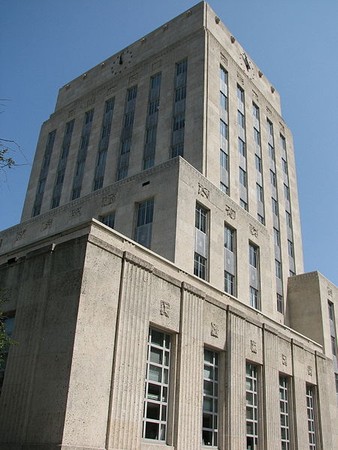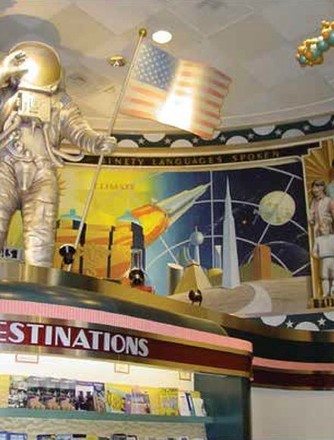Houston City Hall
Introduction
Text-to-speech Audio
Images
Houston City Hall was built in 1939 and is known for its simple architectural style.

The Mural on the ceiling of the first floor lobby epicts industry, culture, law and municipal administration in Houston. In one panel a man appears to be wearing a Confederate officer's uniform.

Backstory and Context
Text-to-speech Audio
Two brothers, J.K. and A.C. Allen, founded Houston on August 30, 1836 just a few months after the end of the Texas War for Independence. They named the new settlement for the hero of that war, General Sam Houston. From 1841 to 1939, Houston municipal government was headquartered at Old Market Square, on a site donated to the City by Houston's founder, the Allen brothers. The City Hall on Market Square was destroyed by fire in the 1870s, and again in 1901, and rebuilt each time.
City Hall in those days was part of the lively commercial atmosphere of Market Square. City offices were located on the second floor of the municipal building. The first floor tenant was a fish market. By the 1920s, it had become apparent that these facilities were no longer adequate for the municipal government. In 1927, voters approved by wide margins bond issues for the construction of a new Civic Center ($1.4 million) and a new City Hall ($1 million).
During the Depression, plans for constructing the City Hall were temporarily sidetracked. In 1933, however, the City applied for a federal Public Works Administration grant to help finance the construction of a new City Hall. Straw votes on building a new City Hall were taken in 1933, 1934 and 1935, In 1934 voters rejected a proposition to build the City Hall, but also voted that if one were to be built, it should be put on the Civic Center site rather than at Market Square. On August 8, 1937, the City Hall W.P.A. grant was approved. The City Commission authorized the taking of bids on the City Hall bond funds originally approved in 1927. Mayor R.H. Fonville and the Commissioners also passed an ordinance designating the west end of Martha Hermann Square as the site of the new City Hall.
Construction began on March 7, 1938. The cornerstone was laid on October 1, 1938. A time capsule was placed in the cornerstone, containing a Bible, copies of the City charter, Houston's three daily newspapers and the City Auditor's report for 1937.
Sources
"Houston City Hall." National Park Service - National Register of Historic Places Nomination Form. September 18, 1990. https://atlas.thc.state.tx.us/NR/pdfs/90001471/90001471.pdf.
